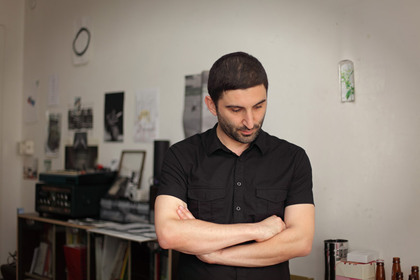-
From Issue 76
-
- Editor’s Letter Structuring a Way Forward
- Reports Seoul
- Reports Empire of Happiness
- Profiles Armenian Center for Contemporary Experimental Art
- Features Within/Without
- Features Art and Censorship in Singapore: Catch 22?
- Reviews Translife
- Reviews Between Heaven and Earth: Contemporary Art from the Centre of Asia
- Reviews Eiko & Koma
- Projects Cevdet Erek
- Table of Contents
- Web Exclusives
- Archive
- Subscribe

R
E
V N
E
X
T
Around the corner from the luxury department store Beymen in the fashionable Nişantaşı neighborhood, Cevdet Erek’s building is besieged by noise: pneumatic drills, honking taxis, the clicking of high-heels on the stone sidewalks. Inside, however, is a hushed bourgeois oasis, with art-nouveau metalwork and a marble staircase. On the third floor, Erek’s door is marked with a small golden square. We immediately begin talking about how the neighborhood has changed, how congested it has become, and his desire for a more tranquil living space with a view of the water.
Sound, time and urban transformation: three currents running through Erek’s various creative enterprises. Trained as an architect at Mimar Sinan University, he is known locally both as an artist and the drummer in the prog-rock band Nekropsi, from his student days in the 1990s, as Turkey was liberalizing, he says. “We were all trying to open up creative space for ourselves, away from the official, the nationalist and the popular.” He got his start in the early 2000s with a series of video installations about specific sites of architectural interest in Istanbul, then created videos shown inside scale models of exhibition venues. Particularly admired among his Istanbul fans is SSS – Shore Scene Soundtrack (2006– ), a performance in which Erek runs his hands over a carpet, imitating the sound of the ocean.
It was the week before the Istanbul Biennial opened, Erek had just returned from Copenhagen, where he and Ahmet Öğüt had opened their first collaborative exhibition, titled “Ahmet Cevdet Bey Presents Tunnel of Fear,” an installation of intentionally (but uncharacteristically, for both artists) kitschy objects culled from Istanbul streets. Over several cups of tea and a spiral-shaped tahini çörek, I was finally able to ask Erek about his recently completed dissertation, defended in June at the Center for Advanced Studies in Music at Istanbul Technical University. He elaborated at length about his research into “the representation of chronology and measured time in sound,” the history of visual representation of time (“a timeline of timelines”) and “sonification”—how we receive information through functional sounds from the environment: “alarms, beeps or the call to prayer.”
Even when his dissertation diverted his attention from art-making, it provided inspiration for his work. This is particularly evident in what are now his most widely circulated pieces, the unconventional types of measuring devices from the “Rulers and Rhythm Studies” series (2007–11), many of which were displayed on a several-meter-long table at the Istanbul Biennial in mid-September. A white plastic one is marked with just two points: “now” and “end.” Ruler 100 Years (with Calendar and Alphabet Revolution) (2011) marks off the last 100 years, printed with the pre-1928 years in Ottoman-script numerals. His Ruler Coup (mini) (2011), denoting the years of revolutions around the world, was distributed to Biennial visitors.
Erek is providing various sound components to Orhan Pamuk’s long-delayed “Museum of Innocence” project, a building based on the novel of the same name, now supposed to open in the Çukurcuma neighborhood in early 2012. But there are certain kinds of urban development, in Nişantaşı for one, that I sensed Erek doesn’t approve of. For example, the construction of the Fatih Sultan Mehmet Bridge (“the second bridge”), which now towers over Rumeli Hisarı, the Bosporus-facing neighborhood where Erek grew up—a photo of the final section of the bridge being lifted into place, taken by his mother, is on the cover of Nekropsi’s album Sayı 2 (2006). Erek reexplores this transformation in his video The 3rd 2nd Bridge (2011), shown in “Seven New Works” (2011) at Borusan Contemporary. The video pairs the daily activities at Erek’s family home with an artificial panoramic view of the Bosporus outside the window; the view is a diptych comprised of two fixed views of the second bridge, from the Asian and European sides, the two bridges appearing to merge into one.
Before leaving, I ask Erek about a seashell wind chime he just purchased (perhaps under the influence of Ahmet Cevdet Bey), and his desire to find a new place, with a view of the water. For now, he has a lone, colorful painting of the ocean by Antonio Consentino hanging crookedly on a lime-yellow wall at the far side of his living room.





